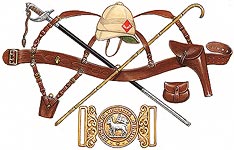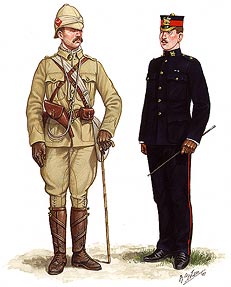South Africa 1899-1902

 |
| Field Officer in Foreign Service Dress, 1899. 2nd Lieutenant in blue Patrol Jacket. He is wearing the Jubilee Medal 1899. |
This battle honour is borne on the Colours and appointments of nearly every Infantry Regiment in the British Army and, in the cavalry, only five regiments did not participate in the campaign. Nearly 400,000 men from the British Empire took part, including Militia battalions and Volunteer companies. Both The Queen’s (Royal West Surrey) Regiment and The East Surrey Regiment earned the two battle honours of THE RELIEF OF LADYSMITH and SOUTH AFRICA, 1899-1902.
 |
| Lance Corporal in Marching Order, Home Service 1899. |
War between the Boers and the British was declared on the 11th October 1899, following a deterioration of their relationship and the British fear that the Boers were trying to establish a Dutch United States of South Africa. The 2nd Battalions of both The Queen’s and The East Surreys embarked for South Africa within a few weeks.
Both Battalions formed part of the 2nd Brigade of the 1st Division, together with the 2nd Devons and the 2nd West Yorks. They trained together, but it soon became apparent that this had not been appropriate for dealing with the Boers, who knew the ground well and were expert guerilla fighters. The British underestimated the strength of the Boers and had 20,000 men spread over a 1000 mile front. Soon Ladysmith was besieged and later Kimberley and Mafeking.
Ladysmith began to be besieged on the 9th November and the Boers were raiding towards the Tugela River, threatening the whole of Natal. The 2nd Brigade moved from Pietermaritzburg to Frere and the Queen’s first engagement was the attack on the village of Colenso on the 15th December. This was part of the period known as the “Black Week” of British defeats. The Battalion was ordered to advance across flat open country in open order and the Boers, in well-prepared positions, put all the British artillery out of action by accurate fire. The Queen’s, supported by the East Surreys, managed to gain the village, but were then ordered to withdraw having lost 100 men. For a further month, the troops remained in camp watching the Boers strengthen their defences on the other side of the Tugela River. The River was crossed eventually on the 18th January and on the 20th, two companies of The Queen’s were ordered to make a frontal assault on a Boer position in order to cover a flanking movement by other units. The result was not good for the Battalion; one officer was killed and three out of the remaining five were hit. One, Lieutenant Smith, was shot in the chest, but managed to lead his men until he fell. He crawled into cover and managed to sketch the enemy positions before he dragged himself back to where the Company was taking cover.
About this time, The Queen’s and East Surreys were joined by their 3rd (Militia) Battalions; the East Surreys also had their 4th (Extra Reserve) Battalion. The Volunteer Company of The Queen’s joined them later. It was an historic event, when the Volunteers joined the Regulars in battle.
Related
